Future Path Presentation to Passengers of an Autonomous Wheelchair Using Vibrotactile Feedback
Abstract
1. Introduction
- We propose a method for presenting a future travel path to passengers of an autonomous wheelchair using an array of tactile devices installed onff the seat.
- We evaluate the proposed method in scenarios where the wheelchair automatically moves left or right to avoid pedestrians and an obstacle.
- We demonstrate that the proposed method enables passengers to more easily understand the future action plan compared to conventional methods, which only indicate the direction of movement.
2. Related Work
2.1. Presentation of Vehicle Behavior to Passengers in Automated Driving
2.2. Presenting Information Through Haptic Feedback
3. Future Path Presentation Using Vibrotactile Sensations
3.1. Information Presentation for Autonomous Wheelchair Passengers
3.2. Presenting Future Behavior via Vibration Propagation
3.3. Timing of Future Path Presentation
4. Experiment
4.1. Experimental Environment
4.2. Condition
4.3. Apparatus
4.3.1. Wheelchair Robot
4.3.2. Vibration Device Installation and Vibration Control
4.4. Participants
4.5. Evaluation
4.6. Procedure
5. Results
6. Discussion
7. Conclusions
Author Contributions
Funding
Institutional Review Board Statement
Informed Consent Statement
Data Availability Statement
Conflicts of Interest
Appendix A. Participant Ratings for Each Condition
| Subject | 1 | 2 | 3 | 4 | 5 | 6 | 7 | 8 | 9 | 10 | 11 | 12 | 13 | 14 | 15 | 16 | 17 | 18 | 19 | 20 |
| A | 7 | 7 | 7 | 5 | 7 | 7 | 7 | 7 | 5 | 6 | 6 | 7 | 7 | 7 | 7 | 2 | 4 | 7 | 6 | 2 |
| B | 7 | 7 | 7 | 7 | 7 | 6 | 7 | 7 | 5 | 6 | 7 | 7 | 1 | 7 | 6 | 6 | 7 | 7 | 5 | 7 |
| C | 1 | 1 | 1 | 1 | 1 | 1 | 1 | 1 | 1 | 1 | 1 | 3 | 1 | 1 | 1 | 1 | 1 | 1 | 1 | 1 |
| Subject | 1 | 2 | 3 | 4 | 5 | 6 | 7 | 8 | 9 | 10 | 11 | 12 | 13 | 14 | 15 | 16 | 17 | 18 | 19 | 20 |
| A | 7 | 7 | 7 | 7 | 2 | 6 | 7 | 7 | 4 | 2 | 4 | 6 | 7 | 7 | 7 | 6 | 7 | 6 | 5 | 1 |
| B | 3 | 5 | 7 | 1 | 2 | 3 | 1 | 2 | 3 | 1 | 1 | 5 | 1 | 1 | 1 | 1 | 1 | 1 | 3 | 6 |
| C | 1 | 1 | 1 | 1 | 1 | 1 | 1 | 1 | 1 | 1 | 1 | 3 | 1 | 1 | 1 | 1 | 3 | 1 | 1 | 1 |
| Subject | 1 | 2 | 3 | 4 | 5 | 6 | 7 | 8 | 9 | 10 | 11 | 12 | 13 | 14 | 15 | 16 | 17 | 18 | 19 | 20 |
| A | 6 | 7 | 7 | 7 | 7 | 7 | 7 | 7 | 5 | 6 | 5 | 7 | 7 | 7 | 7 | 3 | 3 | 7 | 6 | 6 |
| B | 7 | 7 | 7 | 5 | 7 | 7 | 7 | 7 | 4 | 6 | 7 | 7 | 7 | 6 | 7 | 7 | 7 | 7 | 5 | 7 |
| C | 1 | 1 | 1 | 1 | 1 | 1 | 1 | 1 | 1 | 1 | 1 | 4 | 1 | 1 | 1 | 1 | 1 | 1 | 1 | 1 |
| Subject | 1 | 2 | 3 | 4 | 5 | 6 | 7 | 8 | 9 | 10 | 11 | 12 | 13 | 14 | 15 | 16 | 17 | 18 | 19 | 20 |
| A | 7 | 7 | 7 | 3 | 7 | 5 | 5 | 7 | 5 | 5 | 6 | 7 | 6 | 6 | 6 | 5 | 5 | 4 | 6 | 2 |
| B | 7 | 7 | 7 | 1 | 7 | 3 | 5 | 6 | 5 | 3 | 6 | 7 | 3 | 5 | 6 | 7 | 5 | 4 | 5 | 7 |
| Subject | 1 | 2 | 3 | 4 | 5 | 6 | 7 | 8 | 9 | 10 | 11 | 12 | 13 | 14 | 15 | 16 | 17 | 18 | 19 | 20 |
| A | 5 | 6 | 7 | 7 | 6 | 3 | 6 | 7 | 6 | 3 | 6 | 6 | 6 | 6 | 7 | 5 | 7 | 4 | 3 | 2 |
| B | 5 | 5 | 7 | 5 | 7 | 2 | 5 | 5 | 6 | 2 | 5 | 7 | 4 | 6 | 5 | 5 | 5 | 2 | 4 | 6 |
| C | 2 | 1 | 7 | 1 | 6 | 2 | 2 | 1 | 4 | 1 | 2 | 5 | 5 | 3 | 2 | 4 | 6 | 1 | 2 | 2 |
References
- Kuno, Y.; Shimada, N.; Shirai, Y. A Robotic Wheelchair Based on the Integration of Human and Environmental Observations—Look Where You’re Going. IEEE Robot. Autom. Mag. 2003, 10, 26–34. [Google Scholar] [CrossRef]
- Morales, Y.; Kallakuri, N.; Shinozawa, K.; Miyashita, T.; Hagita, N. Human-Comfortable Navigation for an Autonomous Robotic Wheelchair. In Proceedings of the IEEE/RSJ International Conference on Intelligent Robots and Systems (IROS), Tokyo, Japan, 3–7 November 2013; IEEE: Piscataway, NJ, USA, 2013; pp. 2737–2743. [Google Scholar]
- Leaman, J.; La, H.M. A Comprehensive Review of Smart Wheelchairs: Past, Present, and Future. IEEE Trans. Hum.-Mach. Syst. 2017, 47, 486–489. [Google Scholar] [CrossRef]
- Dillen, N.; Ilievski, M.; Law, E.; Nacke, L.E.; Czarnecki, K.; Schneider, O. Keep Calm and Ride Along: Passenger Comfort and Anxiety as Physiological Responses to Autonomous Driving Styles. In Proceedings of the CHI ’20: CHI Conference on Human Factors in Computing Systems, Honolulu, HI, USA, 25–30 April 2020; pp. 1–13. [Google Scholar] [CrossRef]
- Koo, J.; Kwac, J.; Ju, W.; Steinert, M.; Leifer, L.; Nass, C. Why Did My Car Just Do That? Explaining Semi-Autonomous Driving Actions to Improve Driver Understanding, Trust, and Performance. Int. J. Interact. Des. Manuf. 2015, 9, 269–275. [Google Scholar] [CrossRef]
- Haeuslschmid, R.; Von Buelow, M.; Pfleging, B.; Butz, A. Supporting Trust in Autonomous Driving. In Proceedings of the International Conference on Intelligent User Interfaces (IUI 2017), Limassol, Cyprus, 13–16 March 2017; pp. 319–329. [Google Scholar]
- Higashi, Y.; Ikeda, T.; Takai, H.; Iwaki, S. Future Route Presentation to Autonomous Mobile Wheelchair Passengers Using the Movement of Vibrotactile Stimuli. In Proceedings of the Annual Conference of the Society of Instrument and Control Engineers (SICE), Kumamoto, Japan, 6–9 September 2022; IEEE: Piscataway, NJ, USA, 2022; pp. 749–754. [Google Scholar]
- Elbanhawi, M.; Simic, M.; Jazar, R. In the Passenger Seat: Investigating Ride Comfort Measures in Autonomous Cars. IEEE Intell. Transp. Syst. Mag. 2015, 7, 4–17. [Google Scholar] [CrossRef]
- Kobayashi, T.; Ikeda, T.; Kato, Y.O.; Utsumi, A.; Nagasawa, I.; Iwaki, S. Evaluation of Mental Stress in Automated Following Driving. In Proceedings of the International Conference on Robotics and Automation Engineering (ICRAE), Guangzhou, China, 17–19 November 2018; IEEE: Piscataway, NJ, USA, 2018; pp. 131–135. [Google Scholar]
- Richardson, N.T.; Lehmer, C.; Lienkamp, M.; Michel, B. Conceptual Design and Evaluation of a Human Machine Interface for Highly Automated Truck Driving. In Proceedings of the IEEE Intelligent Vehicles Symposium (IV), Changshu, China, 26–30 June 2018; IEEE: Piscataway, NJ, USA, 2018; pp. 2072–2077. [Google Scholar]
- De Winter, J.C.F.; Happee, R.; Martens, M.H.; Stanton, N.A. Effects of Adaptive Cruise Control and Highly Automated Driving on Workload and Situation Awareness: A Review of the Empirical Evidence. Transp. Res. Part F Traffic Psychol. Behav. 2014, 27, 196–217. [Google Scholar] [CrossRef]
- Hashimoto, R.; Nomura, R.; Kanbara, M.; Ukita, N.; Ikeda, T.; Morales, Y.; Watanabe, A.; Shinozawa, K.; Hagita, N. Behavior Representation of Robotic Wheelchairs with Physiological Indices for Passenger Comfort. In Proceedings of the IEEE International Conference on Vehicular Electronics and Safety (ICVES), Yokohama, Japan, 5–7 November 2015; IEEE: Piscataway, NJ, USA, 2015; pp. 158–163. [Google Scholar]
- Watanabe, A.; Ikeda, T.; Morales, Y.; Shinozawa, K.; Miyashita, T.; Hagita, N. Communicating Robotic Navigational Intentions. In Proceedings of the IEEE/RSJ International Conference on Intelligent Robots and Systems (IROS), Hamburg, Germany, 28 September–2 October 2015; IEEE: Piscataway, NJ, USA, 2015; pp. 5763–5769. [Google Scholar]
- Enami, K.; Okuoka, K.; Akita, S.; Imai, M. Notification Timing of Agent with Vection and Character for Semi-Automatic Wheelchair Operation. In Proceedings of the International Conference on Human-Agent Interaction, Kyoto, Japan, 6–10 October 2019; ACM: New York, NY, USA, 2019; pp. 127–134. [Google Scholar]
- Yoshitake, H.; Harada, R.; Shino, M. Can Information Presentation Using a Mixed Reality Device Reduce Anxiety of Autonomous Driving? A Preliminary Study in Simulator Environment. In Proceedings of the IEEE Conference on Systems, Man, and Cybernetics (SMC2023), Oahu, HI, USA, 1–4 October 2023; pp. 2771–2772. [Google Scholar]
- Shiomi, M.; Iio, T.; Kamei, K.; Sharma, C.; Hagita, N. User-Friendly Autonomous Wheelchair for Elderly Care Using Ubiquitous Network Robot Platform. In Proceedings of the International Conference on Human-Agent Interaction (HAI), Tsukuba, Japan, 28–31 October 2014; ACM: New York, NY, USA, 2014; pp. 17–22. [Google Scholar]
- Petermeijer, S.M.; Abbink, D.A.; Member, S.; Mulder, M.; Winter, J.C.F. De The Effect of Haptic Support Systems on Driver Performance: A Literature Survey. IEEE Trans. Haptics 2015, 8, 467–479. [Google Scholar] [CrossRef] [PubMed]
- Gaffary, Y.; Lécuyer, A. The Use of Haptic and Tactile Information in the Car to Improve Driving Safety: A Review of Current Technologies. Front. ICT 2018, 5, 5. [Google Scholar] [CrossRef]
- van Erp, J.B.F.; van Veen, H.A.H.C. Vibrotactile In-Vehicle Navigation System. Transp. Res. Part F Traffic Psychol. Behav. 2004, 7, 247–256. [Google Scholar] [CrossRef]
- Stanley, L.M. Haptic and Auditory Cues for Lane Departure Warnings. Proc. Hum. Factors Ergon. Soc. Annu. Meet. 2006, 50, 2405–2408. [Google Scholar] [CrossRef]
- Scott, J.J.; Gray, R. A Comparison of Tactile, Visual, and Auditory Warnings for Rear-End Collision Prevention in Simulated Driving. Hum. Factors J. Hum. Factors Ergon. Soc. 2008, 50, 264–275. [Google Scholar] [CrossRef] [PubMed]
- Chang, W.; Hwang, W.; Ji, Y.G. Haptic Seat Interfaces for Driver Information and Warning Systems. Int. J. Hum. Comput. Interact. 2011, 27, 1119–1132. [Google Scholar] [CrossRef]
- Tan, H.Z.; Gray, R.; Young, J.J.; Traylor, R. A Haptic Back Display for Attentional and Directional Cueing. Haptics-e 2003, 3, 1–20. [Google Scholar]
- van Erp, J.B.F.; van Veen, H.A.H.C.; Jansen, C.; Dobbins, T. Waypoint Navigation with a Vibrotactile Waist Belt. ACM Trans. Appl. Percept. 2005, 2, 106–117. [Google Scholar]
- Asif, A.; Boll, S. Where to Turn My Car? Comparison of a Tactile Display and a Conventional Car Navigation System under High Load Condition. In Proceedings of the International Conference on Automotive User Interfaces and Interactive Vehicle Applications (AutomotiveUI), Pittsburgh, PA, USA, 11–12 November 2010; pp. 64–71. [Google Scholar]
- Chen, X.; Agrawal, S.K. Assisting versus Repelling Force-Feedback for Human Learning of a Line Following Task. In Proceedings of the IEEE International Conference on Biomedical Robotics and Biomechatronics (BioRob), Rome, Italy, 24–27 June 2012; IEEE: Piscataway, NJ, USA, 2012; pp. 344–349. [Google Scholar]
- Devigne, L.; Aggravi, M.; Bivaud, M.; Balix, N.; Teodorescu, C.S.; Carlson, T.; Spreters, T.; Pacchierotti, C.; Babel, M. Power Wheelchair Navigation Assistance Using Wearable Vibrotactile Haptics. IEEE Trans. Haptics 2020, 13, 52–58. [Google Scholar] [CrossRef] [PubMed]
- Harrar, V.; Winter, R.; Harris, L.R. Visuotactile Apparent Motion. Percept. Psychophys. 2008, 70, 807–817. [Google Scholar] [CrossRef] [PubMed][Green Version]
- Ishii, Y.; Ikeda, T.; Kobayashi, T.; Kato, Y.O.; Utsumi, A.; Nagasawa, I.; Iwaki, S. Investigation of the Driver’ s Seat That Displays Future Vehicle Motion. In Proceedings of the IEEE International Conference on Robot & Human Interactive Communication (RO-MAN), New Delhi, India, 14–18 October 2019; pp. 148–153. [Google Scholar]
- Thrun, S.; Burgard, W.; Fox, D. Probabilistic Robotics; MIT Press: Cambridge, MA, USA, 2005; ISBN 978-0262201629. [Google Scholar]
- Weinstein, S. Intensive and Extensive Aspects of Tactile Sensitivity as a Function of Body Part, Sex, and Laterality. In The Skin Senses; Kenshalo, D., Ed.; Thomas: Edinburgh, UK, 1968; pp. 195–222. [Google Scholar]
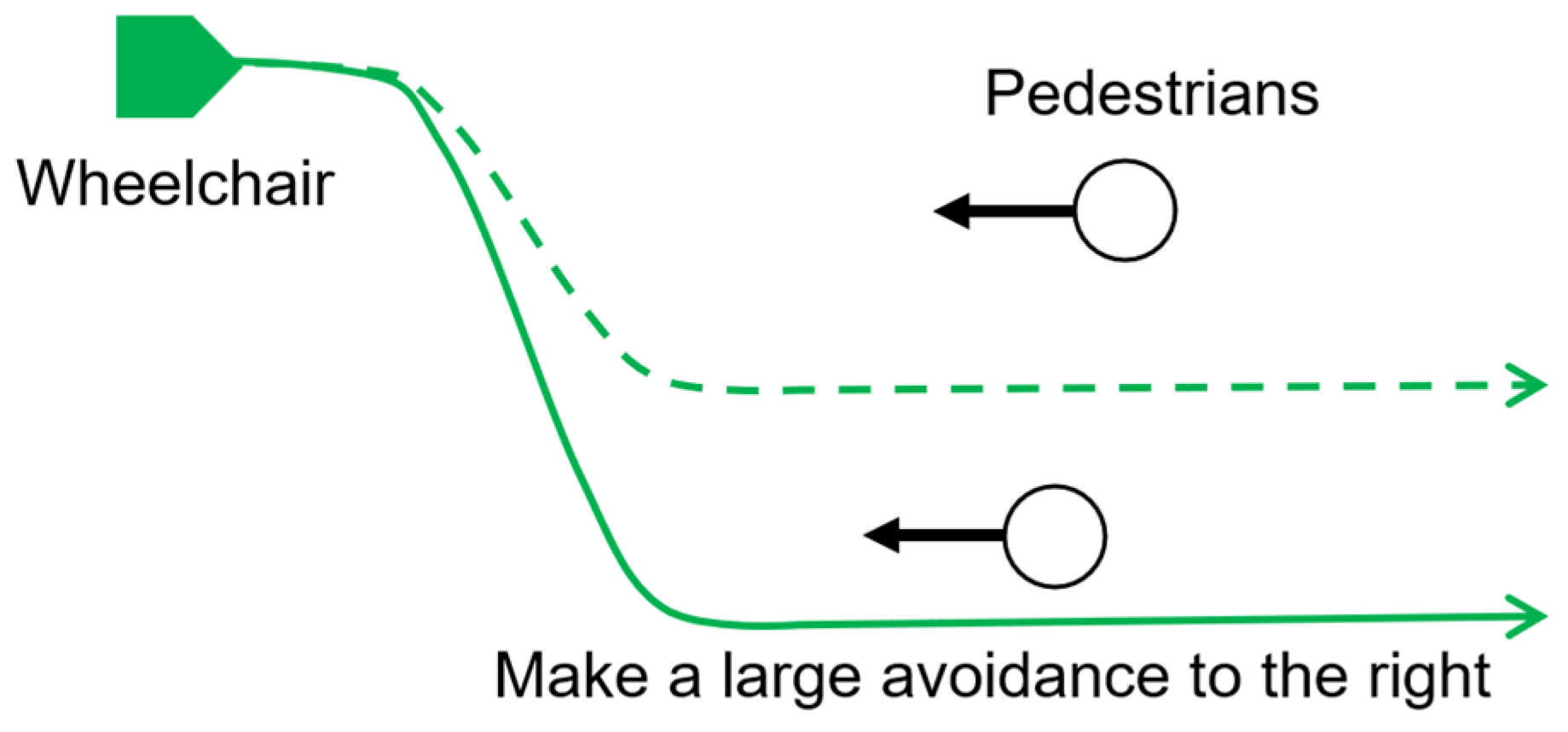
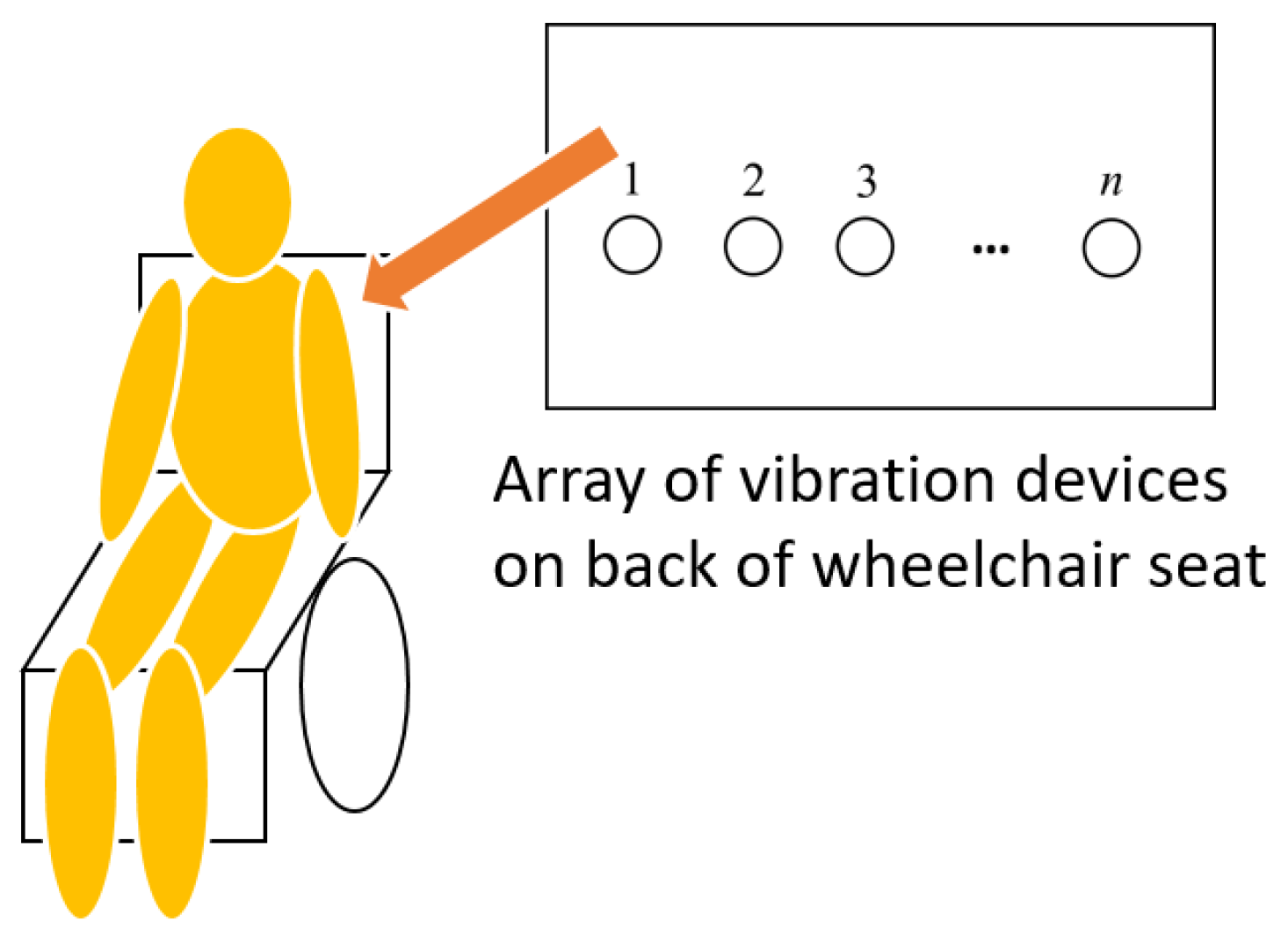



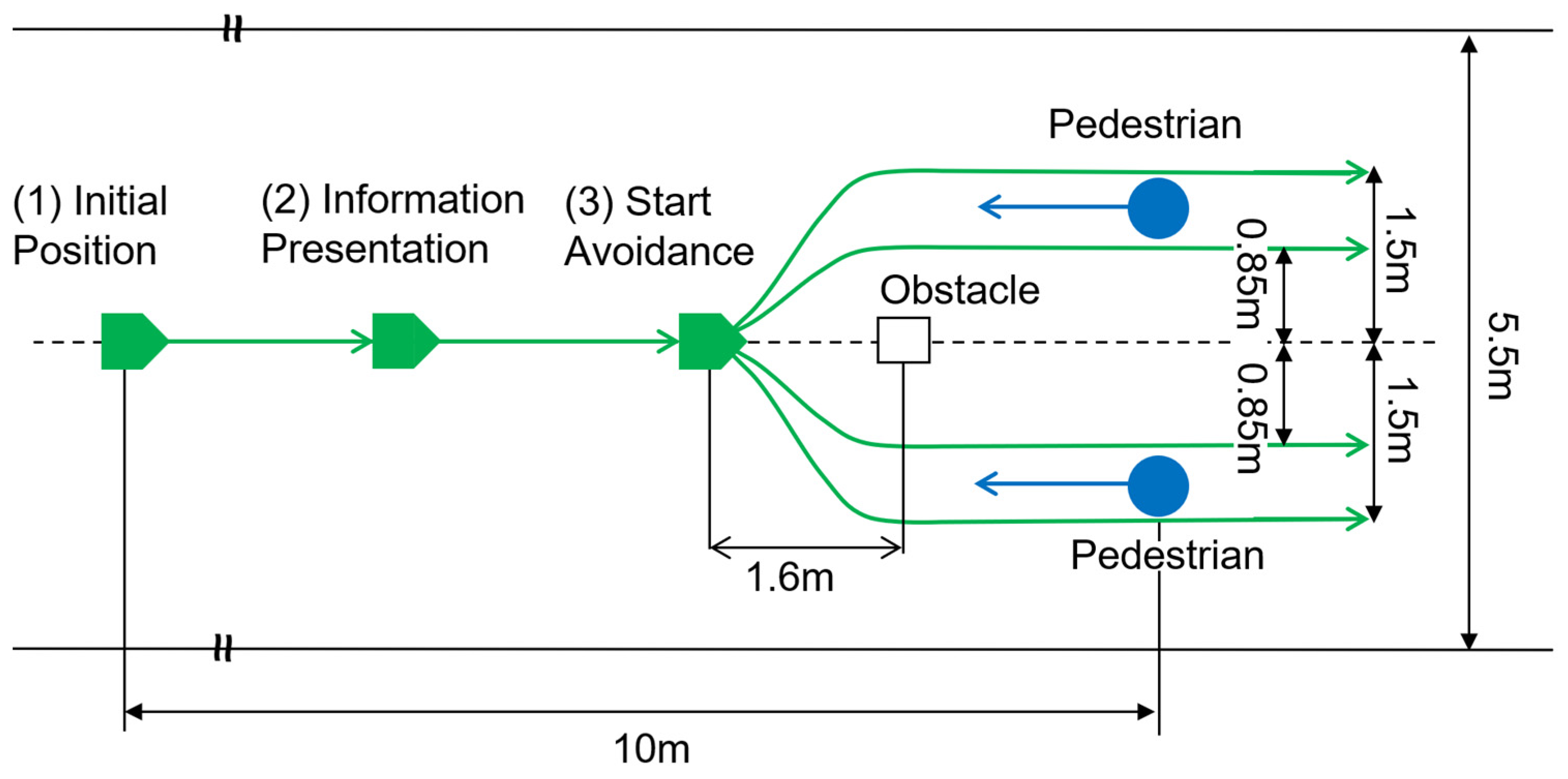

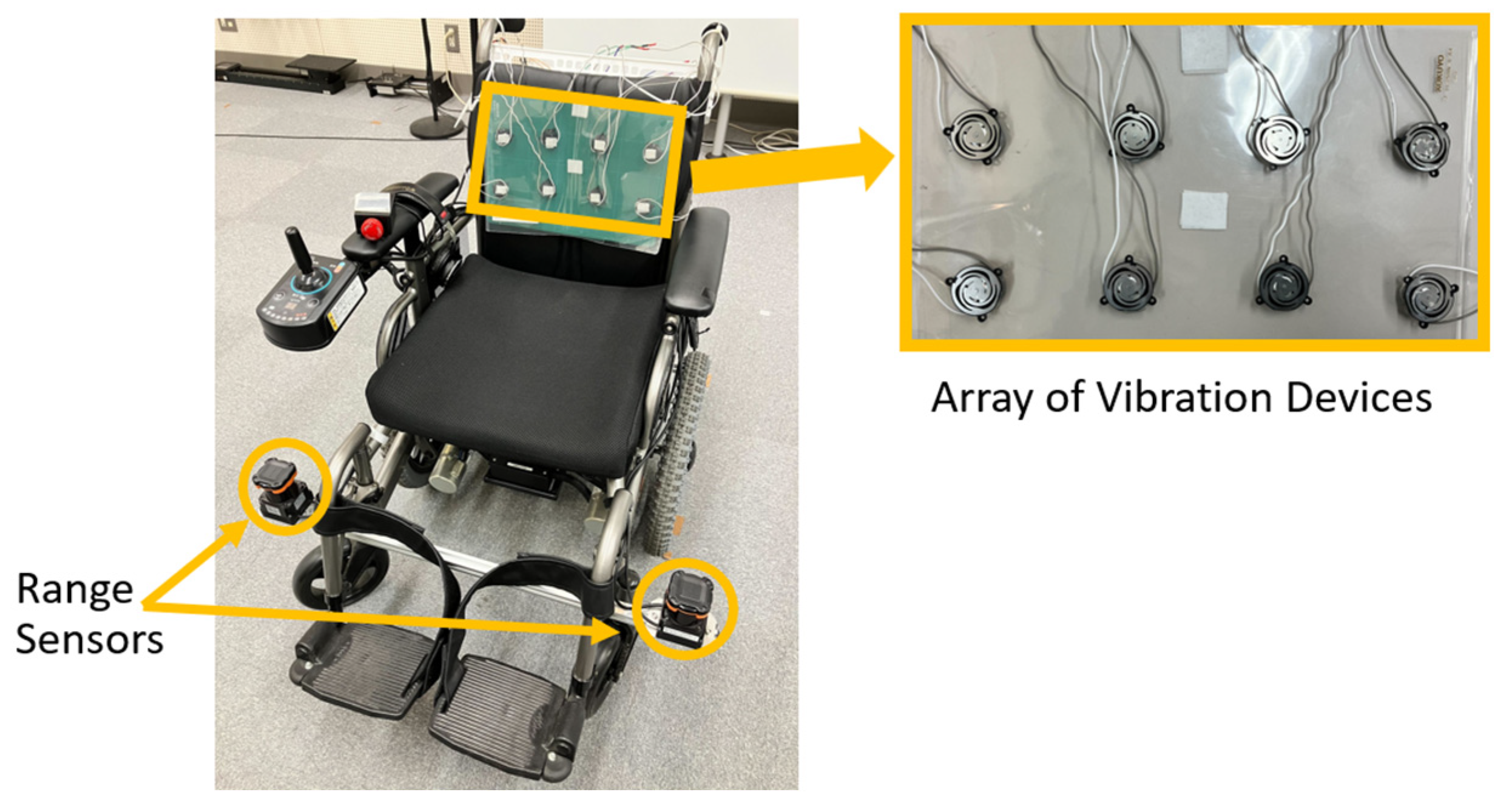
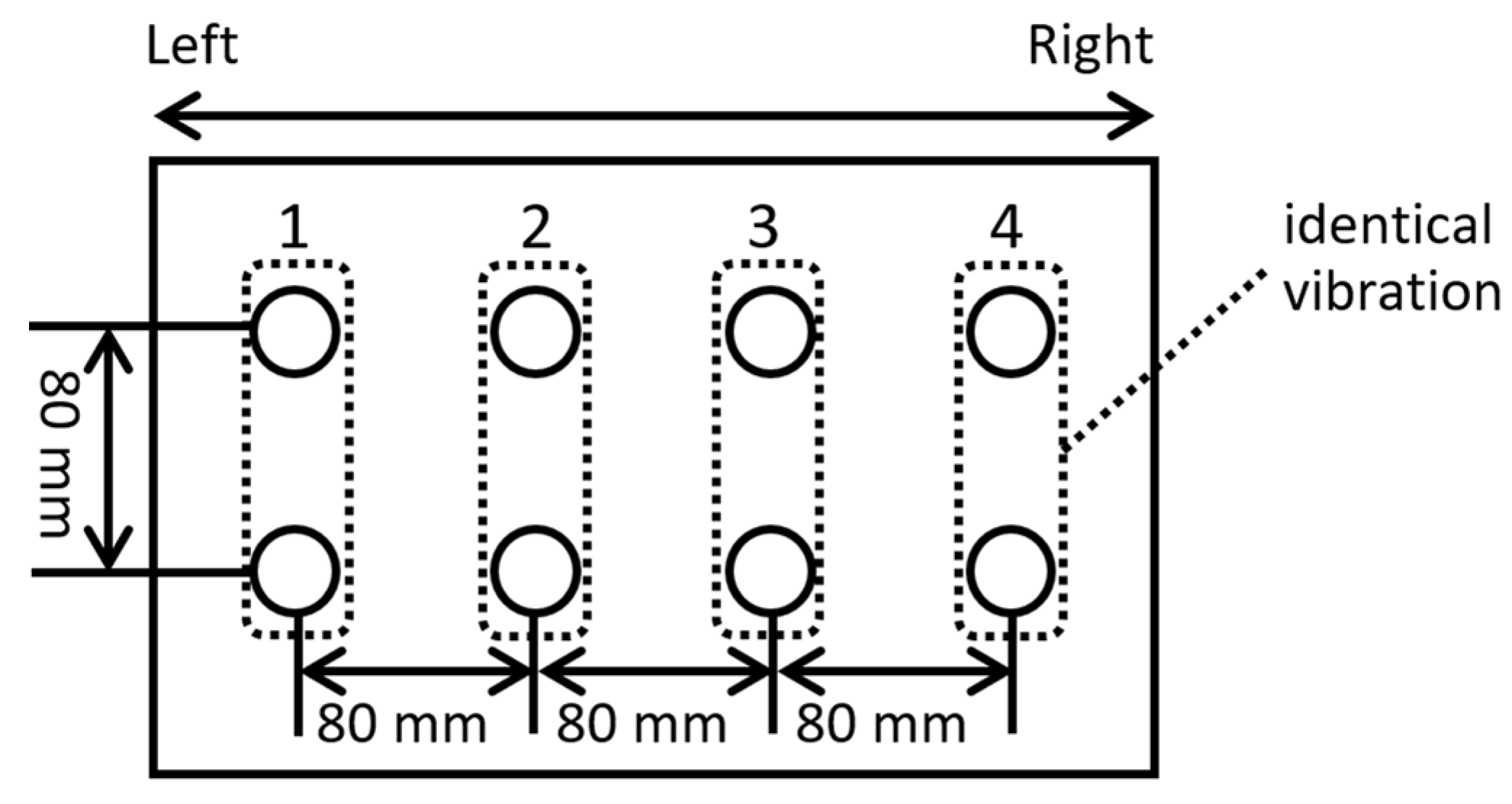



| Condition | Information Presentation |
|---|---|
| A | The future path was presented in advance (proposed method) |
| B | The direction of left or right avoidance was presented in advance |
| C | No path information |
Disclaimer/Publisher’s Note: The statements, opinions and data contained in all publications are solely those of the individual author(s) and contributor(s) and not of MDPI and/or the editor(s). MDPI and/or the editor(s) disclaim responsibility for any injury to people or property resulting from any ideas, methods, instructions or products referred to in the content. |
© 2025 by the authors. Licensee MDPI, Basel, Switzerland. This article is an open access article distributed under the terms and conditions of the Creative Commons Attribution (CC BY) license (https://creativecommons.org/licenses/by/4.0/).
Share and Cite
Higashi, Y.; Takai, H.; Ikeda, T. Future Path Presentation to Passengers of an Autonomous Wheelchair Using Vibrotactile Feedback. Sensors 2025, 25, 1714. https://doi.org/10.3390/s25061714
Higashi Y, Takai H, Ikeda T. Future Path Presentation to Passengers of an Autonomous Wheelchair Using Vibrotactile Feedback. Sensors. 2025; 25(6):1714. https://doi.org/10.3390/s25061714
Chicago/Turabian StyleHigashi, Yusuke, Hiroyuki Takai, and Tetsushi Ikeda. 2025. "Future Path Presentation to Passengers of an Autonomous Wheelchair Using Vibrotactile Feedback" Sensors 25, no. 6: 1714. https://doi.org/10.3390/s25061714
APA StyleHigashi, Y., Takai, H., & Ikeda, T. (2025). Future Path Presentation to Passengers of an Autonomous Wheelchair Using Vibrotactile Feedback. Sensors, 25(6), 1714. https://doi.org/10.3390/s25061714





